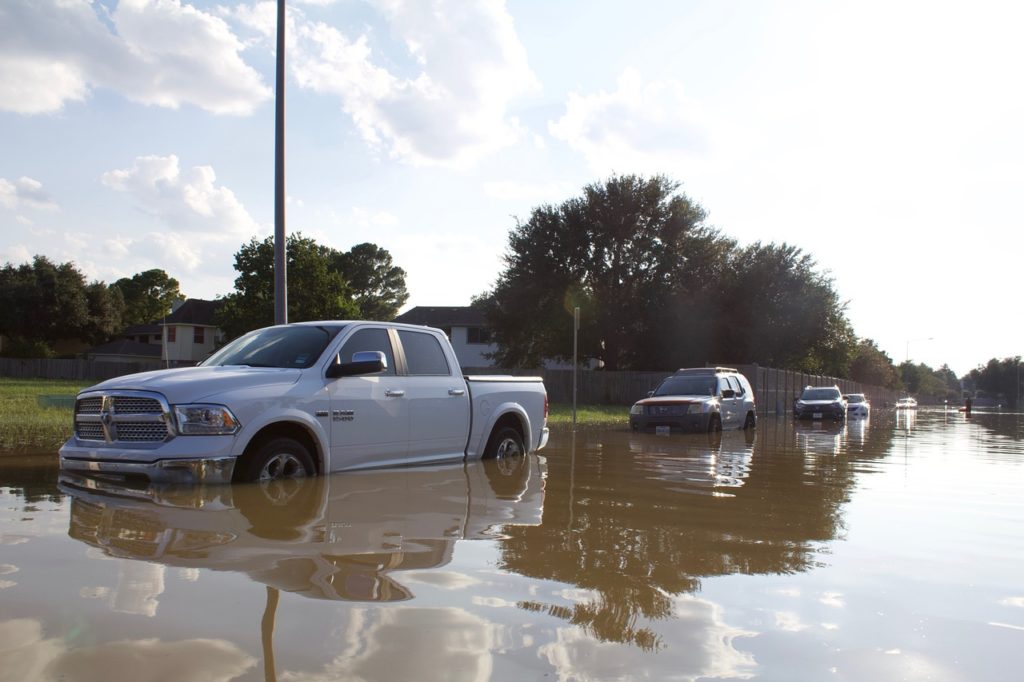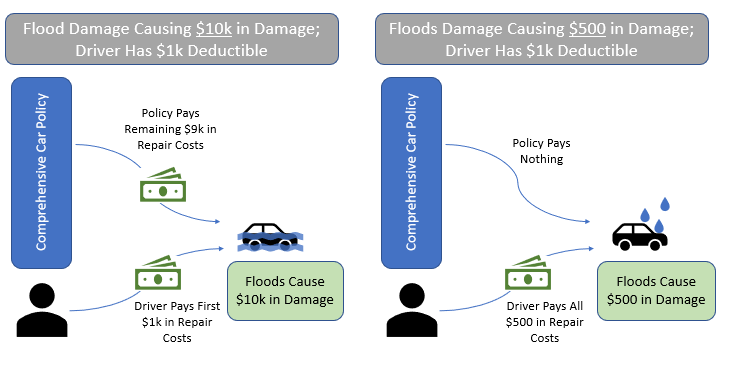
It can be disheartening to find your car damaged or submerged after major flooding. Luckily though, flood damage IS covered by most drivers’ car insurance policies! In this article we walk through the key questions drivers have about flood damage, including the type of insurance coverage you will need, the consequences of flood damage, and when you should make an insurance claim for repairs.
Table of Contents
How much damage does flooding do to a car?
The cost of flood damage to a car can be very significant. If water gets into your car it can not only wreck your interior, but can also cause damage to your electronics, engine, and transmission. This damage can be incredibly costly and present major safety issues. Worst of all, if your car was submerged and water entered the engine, there is a very good chance your car is a total loss.
When is flood damage covered by car insurance?
Generally, flood damage to your car IS covered by a comprehensive car insurance policy. Comprehensive car insurance is a broad policy that covers repairs if your car is damaged by something other than a collision, such as by hail, rodents, lightning, and fires. Nearly 80% of drivers have some form of comprehensive coverage, so the chances are very good that you will be covered for flood damage. In addition, if your car is financed or leased, you will almost certainly have comprehensive coverage because most lenders require it.
Although most flood damage is covered by a comprehensive policy, there are three cases when flood damage will NOT be covered by your car insurance:
- Negligence: if your car was flooded due to your negligence, for example, if you left your windows down or your sunroof open, you are unlikely to be covered.
- If Damage Occurred Over a Long Period of Time: if water damage occurred due to small leaks in your car and a gradual build-up of water – instead of in a single flooding event – the damage is not likely to be covered by your car insurance.
- Owner-Installed Electronics: if floodwaters have damaged electronics you installed, such as GPS devices, televisions, or scanners, these items are unlikely to be covered by your insurance policy.
Is flood damage covered by car insurance even if you drove through a puddle or flooded street?
Yes! Even if you submerged your car by driving through a puddle or flooded street, you are still likely to be covered under your comprehensive policy. Comprehensive coverage kicks in whether the flood damage occurred while your car was being driven or while it was parked.
A storm is coming, can I add comprehensive coverage now?
Unfortunately, most car insurance companies will NOT allow you to add comprehensive coverage if there is a major storm in the forecast. If you need to add comprehensive coverage to your policy you should do it right away – don’t wait for a storm!
Should you make an insurance claim for flood damage?
Flood damage should almost always be repaired, but should you make an insurance claim for the repair? Or should you just pay for the repair yourself? Making an insurance claim for flood damage WILL go on your insurance record. And, unfortunately, adding a claim to your insurance record will typically increase the cost of your car insurance.
It is impossible to know precisely how much an insurance company will raise your rates due to a flood claim. Unlike other claims, however, one source found that making a comprehensive claim (like a claim for flood damage) has a very small impact on your insurance rates. In fact, in some states such as California and Oklahoma, it is actually illegal for an insurance company to raise your rates after you make this type of claim.
Since your rates will only rise slightly – and flooding can cause serious damage – it will almost always make sense to file an insurance claim for flood damage. However, you should still consider how extensive the damage is and the size of your deductible (the deductible is the amount that you will need to pay out of pocket before your insurance coverage kicks in). Below we lay out an example of how a $1k deductible works when flooding causes $10k in damage, compared to an example where flooding only causes $500 in damage.

One of the only times you should NOT make an insurance claim is if the cost of repairing flood damage is less than your deductible. When the cost of your claim is below your deductible, you won’t receive any payment from your insurance company and your rates might go up!
How does the claim process work for flood damage?
Immediately upon your car flooding, you should call your insurance company and file a claim. Every insurer’s claim process is different, but if you give your insurance company a call they will walk you through the steps to formally file a claim. Remember that flood damage typically impacts many people at once, so it is very likely that your insurance company will be dealing with calls from many drivers at once. Be sure to remain patient and, if possible, try to call your insurer as soon as possible to start the claim process.
Typically after filing a claim, you will be assigned an insurance adjuster who will help manage your case. When there is widespread flooding that impacts many people, it can sometimes take several weeks for an insurance adjuster to assist you. While you wait for an insurance adjuster, you can take several steps to mitigate the flood damage. For example, you can begin drying out your car, draining the oil and other fluids, and vacuuming or removing standing water. During this period do NOT attempt to start your car – starting your car will ruin it if there is water in the engine!
Once your adjuster is assigned to you, they will typically work with a local repair shop to assess the damage to your car. Flood damage can be extremely damaging to your car, so don’t be surprised if your insurance company declares that your car is totaled. When your car is totaled, your insurance company will give you a check for the cash value of your car, which you can use to purchase a new vehicle.
How should you prevent flood damage to your car?
It may be too late to prevent damage to your car this time, but in the future, there are several strategies you can take advantage of to avoid flood damage:
- Park in a covered, elevated area: as soon as heavy storms are in the forecast, move your car into your garage or carport. If your garage is also prone to flooding, identify public parking garages near you and plan to keep your car there during future storms.
- Avoid flooded streets: puddles and flooded streets can have much deeper water than they appear! It’s never worth the risk to drive through a flooded area and potentially submerge your car. Avoid flooded roads at all costs while driving.
- Don’t drive! while not always possible, avoiding driving completely during storms is the safest way to protect your car from being submerged. This will ensure you are not caught in dangerous flash flooding.
